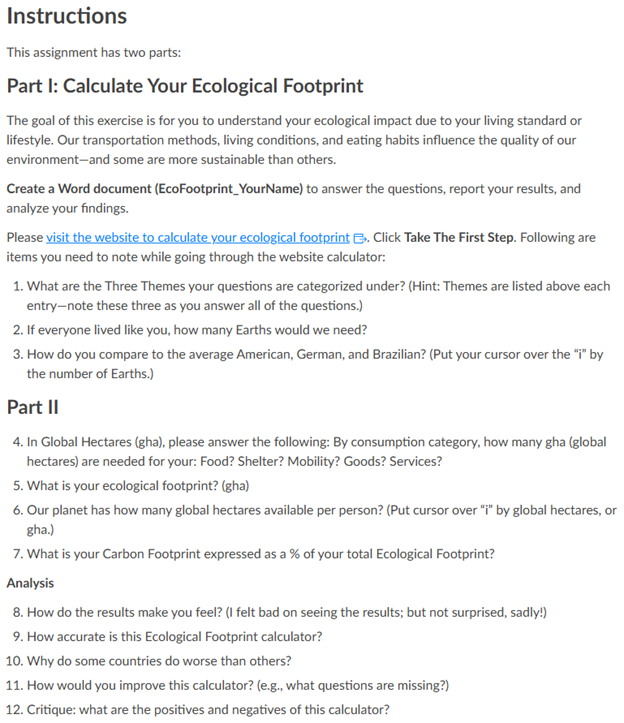Analyzing an Ecological Footprint Tool
Overview
Students use an ecological footprint calculator to reflect on the environmental impact of their lifestyle, connect their results to course concepts, and think critically about the tool itself.
Why Use This?
This is a fun way to encourage students to critically evaluate a tool and their own thinking and perceptions.
⭐What Students Think
Even though many students feel embarrassed and frustrated by their ecological footprint results, they often use this exercise as a source of motivation to change their behaviors. For example, students wanted to explore electric vehicles, look into buying more locally, see if they can live closer to where their work, and investigate renewable energy options. The ecological footprint calculator was just the starting point into self-reflection and for students to think more sustainably.
How Does It Work?
By entering real data about their daily routines and consumption habits into the ecological footprint calculator, students connect abstract course concepts to their own lives. The results often prompt reflection not only on individual behaviors but also on broader societal patterns. In addition to analyzing their outcomes, students are encouraged to think critically about the tool itself by examining its accuracy and limitations.

This assignment has two parts:
Part I: Calculate Your Ecological Footprint
The goal of this exercise is for you to understand your ecological impact due to your living standard or lifestyle. Our transportation methods, living conditions, and eating habits influence the quality of our environment—and some are more sustainable than others.
Create a Word document (EcoFootprint_YourName) to answer the questions, report your results, and analyze your findings.
Please visit the website to calculate your ecological footprintLinks to an external site.. Click Take The First Step. Following are items you need to note while going through the website calculator:
1. What are the Three Themes your questions are categorized under? (Hint: Themes are listed above each entry—note these three as you answer all of the questions.)
2. If everyone lived like you, how many Earths would we need?
3. How do you compare to the average American, German, and Brazilian? (Put your cursor over the “i” by the number of Earths.)
Part II
4. In Global Hectares (gha), please answer the following: By consumption category, how many gha (global hectares) are needed for your: Food? Shelter? Mobility? Goods? Services?
5. What is your ecological footprint? (gha)
6. Our planet has how many global hectares available per person? (Put cursor over “i” by global hectares, or gha.)
7. What is your Carbon Footprint expressed as a % of your total Ecological Footprint?
Analysis
8. How do the results make you feel? (I felt bad on seeing the results; but not surprised, sadly!)
9. How accurate is this Ecological Footprint calculator?
10. Why do some countries do worse than others?
11. How would you improve this calculator? (e.g., what questions are missing?)
12. Critique: what are the positives and negatives of this calculator?
Keep In Mind
- Students might feel uncomfortable or discouraged by their results. Remind them that the goal is to learn and grow, not to be judged.
- The ecological footprint calculator is not a perfect tool. It makes assumptions that may not match every student’s situation. Encourage discussion about what’s missing or what could be done differently.
- Consider sharing examples of small, realistic lifestyle changes or local organizations students can join to help them feel empowered and motivated to take action.